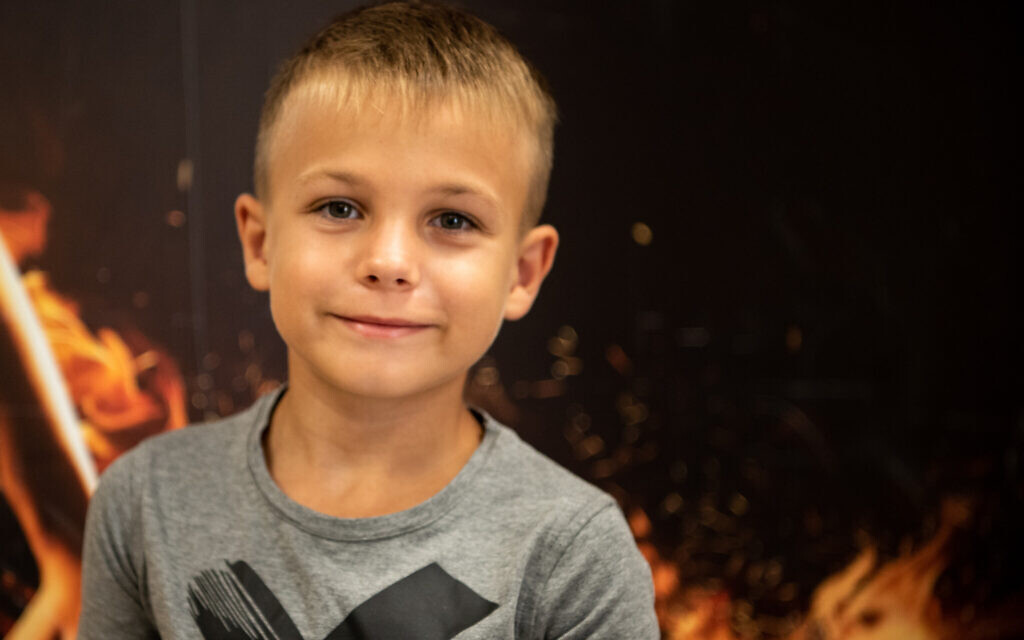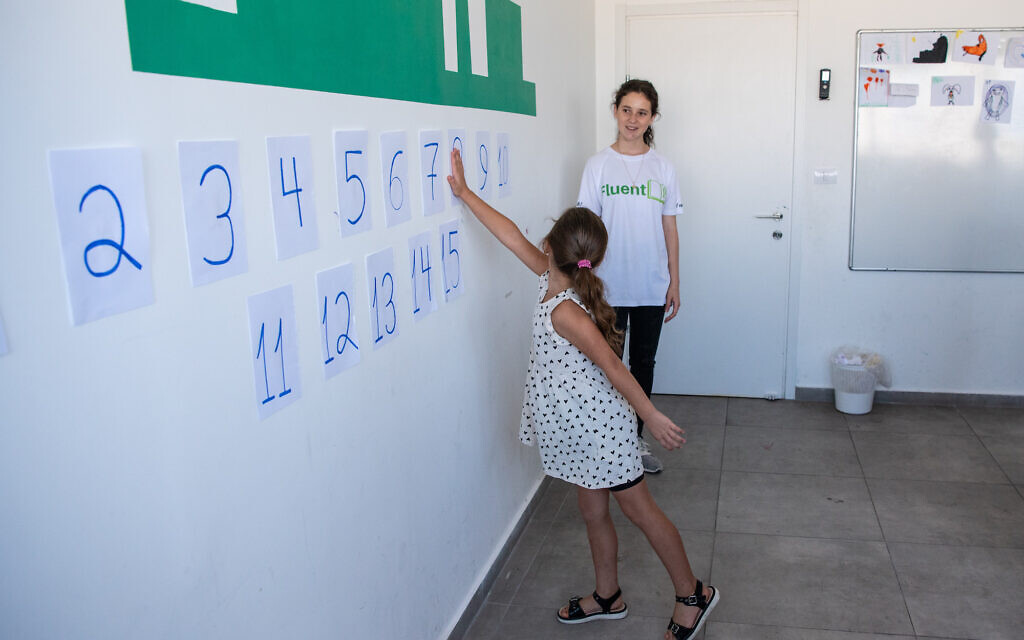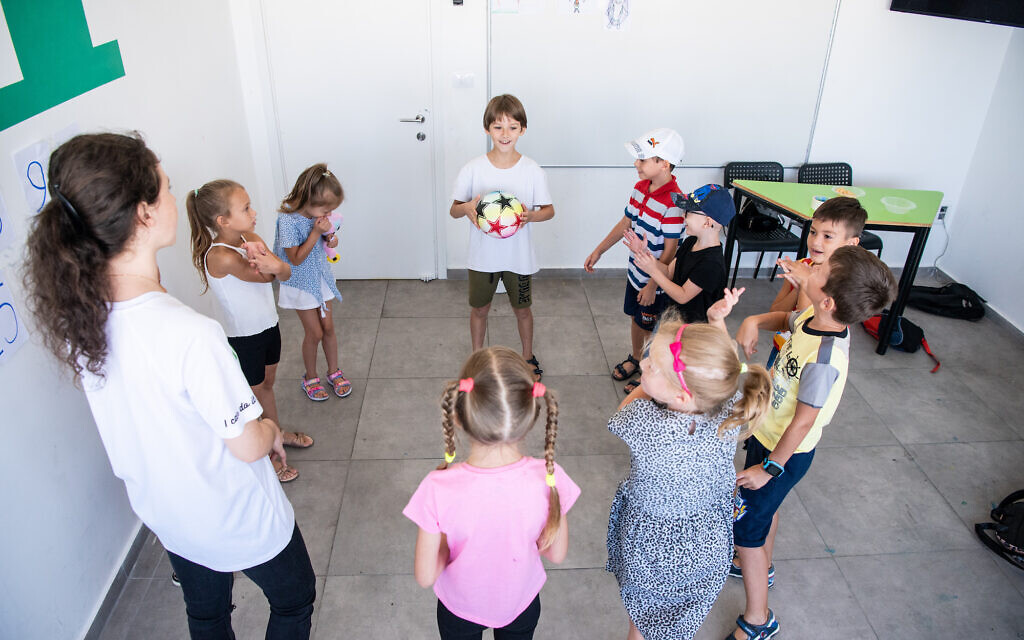[ad_1]
Dima can count to 10 in Hebrew. He knows how to say “yes” and “no” and “what’s that?” but his vocabulary is fairly limited beyond that. This week though, he will start first grade at Yitzhak Sadeh Elementary School in the Tel Aviv suburb of Bat Yam.
“He doesn’t speak Hebrew fluently yet, but he’s picking it up quickly,” his mother, Yulia Pizh, told The Times of Israel last week, speaking in Russian through a translator.
Six-year-old Dima is one of the more than 1,311 Ukrainian immigrants who will enter the Israeli school system at the start of the academic after they fled to the Jewish state due to the Russian invasion of their country, according to the Education Ministry.
They will be joined by another 851 new immigrants from Russia and 105 from Belarus, who left their countries following Moscow’s offensive that began in February. For accounting purposes, the ministry also has a separate category for the 330 children who immigrated to Israel from these countries without their parents who will also enroll in Israeli schools this week.
Though hundreds of new immigrants — known in Hebrew as olim — join the Israeli school system each year, these nearly 2,600 students from the former Soviet Union were part of the largest wave of immigration to reach Israel in over two decades. In total, some 31,000 people have so far immigrated to Israel, or made aliyah as it’s referred to in Hebrew, from Ukraine (over 12,000) and Russia (nearly 19,000) in the aftermath of the Russian invasion of Ukraine and the latter countries’ crackdowns at home. Belarus has also seen a larger-than-normal wave of migration, but current totals were not immediately available.
In addition to the new immigrants, nearly 300 refugees — Ukrainians who entered Israel on tourist visas — will also join the Israeli school system, the Education Ministry said.
Tira Glinoier, who heads the Education Ministry’s immigrant absorption department said this was the first time that she was aware of where the government was offering schooling to refugees in the country on tourist visas.
Though these new immigrants and refugees are spread throughout 92 different municipalities, about half of them are clustered in 10 cities: Jerusalem, Netanya, Haifa, Tel Aviv, Raanana, Rishon LeZion, Beit Shemesh, Ashkelon, Ashdod and Beersheba.
These aren’t people who sat in [Hebrew classes] and learned some Hebrew in Ukraine first. These aren’t people who were planning to make aliyah. They are starting from zero.
This influx represents a major challenge to the education system, both in terms of the large number of immigrants and the fact that many fled to Israel suddenly due to war, unlike most new arrivals who are able to prepare for their move in advance.
“These aren’t people who sat in [Hebrew classes] and learned some Hebrew in Ukraine first,” said Benny Haddad, head of the International Fellowship of Christians and Jews’ immigration department, which helps both with the immigration and integration of Ukrainian Jews in Israel.
“These aren’t people who were planning to make aliyah,” he said, using the Hebrew term for Jewish immigration to Israel. “They are starting from zero.”

Jewish immigrants fleeing from war zones in the Ukraine arrive at the immigration and absorption office, at Ben Gurion airport near Tel Aviv, on March 15, 2022. (Tomer Neuberg/Flash90)
While 2,600 new immigrants from Eastern Europe will be entering the Israeli school system, more than twice that number will be staying home for a variety of reasons, including parents wanting to home-school their children or families still deciding where to settle down, according to the Education Ministry.
Deganit Sankar-Langa, director-general of the Immigration and Absorption Ministry said her office is in constant contact with these families, trying to convince them to enroll their children in Israeli schools.
“We believe that this is the way to ensure the best possible absorption,” Sankar-Langa said.
For the new immigrant students who are enrolled, Israeli schools will be tasked with helping them overcome significant language barriers and other cultural differences. They will also have to ensure that these children, many of whom were subjected to the visceral horrors of war and the sudden escape from their homes, receive the social services and mental health care that they need, while not stigmatizing them in the process. The parents, most of whom also do not yet speak Hebrew, will also have to learn to navigate a new and different educational system for their children, while also integrating themselves into life in Israel by finding jobs and learning the language.
Adding to the complexities of the wave of immigration from Ukraine are Kyiv’s conscription laws, which keep military-aged men from leaving, forcing many of the children to arrive in Israel without their fathers who stayed behind to enlist.
Fun and educational camps
Over the past six months, government ministries, municipalities and non-profits have worked both to prepare the new immigrants to enter the education system as well as to prepare the education system to integrate the new immigrants.
This included establishing summer camps for immigrant children across the country and holding workshops for their parents about the nuances of the Israeli school system and for educators about the specific challenges and characteristics of these new immigrants.
The camps, many of which were funded in part by the International Fellowship of Christians and Jews (IFCJ) but run by local governments, were aimed at teaching the children Hebrew; exposing them to Israeli society, culture and history, as well as to their newly adopted hometowns; and giving them an enjoyable summer.
“The camps weren’t just an ulpan,”Haddad said, using the Hebrew term for Hebrew-language instruction courses. “They were a lot of things, including fun.”
Dima, who fled Ukraine with his mother after their town of Nikolaev came under Russian bombardment, went through one such IFCJ camp in the Tel Aviv suburb of Bat Yam.

Dima Pizh, 6, at a summer camp in Bat Yam that was put on for new immigrants from Ukraine in the summer of 2022. (International Fellowship of Christians and Jews)
“Oh, I just loved this camp! My son met new friends and had wonderful teachers there. They acquainted the children with Jewish and Israeli culture and helped them develop communication skills,” his mother Yulia said.
“They had excursions every other day. They have already been to Jerusalem and to the zoo. This summer camp helped a lot with a softer integration into the school environment,” she added.
Yulia Pizh lauded the IFCJ, which had also helped them get out of Ukraine and navigate the immigration process.
The camps were specifically geared toward new immigrants, but if some non-Jewish refugees joined them “no one was going to kick them out,” he said.
It’s less about grammar and more about the ability to integrate. They should be able to get by, to understand what the teacher said more or less, what their friend says in the hallway.
Haddad said the goal was not to give the kids a Hebrew boot camp but to give them “a basis for them to start.”
“It’s less about grammar and more about the ability to integrate,” he said.
“They should be able to get by, to understand what the teacher said more or less, what their friend says in the hallway.”

New immigrant children from Ukraine take part in a camp in the Tel Aviv suburb of Bat Yam in the summer of 2022. (International Fellowship of Christians and Jews)
Haddad, who has for years worked in helping immigrants, estimated that within six months most of the new immigrant children will be conversant in Hebrew.
He said the staff running the camps were aware of the need to be sensitive to the potential emotional problems facing the children, but that this was not necessarily their primary focus.
“We weren’t doing individual treatments for kids who suffered trauma. But we knew that all of the kids were coming from a place of trauma, that they went through something difficult. Even those who weren’t in cities that were bombed still had to flee their homes quickly,” Haddad said.

New immigrant children from Ukraine take part in a camp in the Tel Aviv suburb of Bat Yam in the summer of 2022. (International Fellowship of Christians and Jews)
In addition to the programming for the kids, the summer camps also offered informal classes for parents.
“We worked with parents to explain to them about the parent-teacher relationship in Israel because it’s very different,” Haddad said.
Indeed, Israel’s school system is famously (maybe notoriously) laid back, with teachers being referred to by their first names and parents feeling more than comfortable calling their children’s teachers to complain.
Dima’s mom Yulia said there were some “technical differences” between the Israeli and Ukrainian school systems, with the former ending earlier in the day, as well as some cultural differences
“His Israeli kindergarten was more lenient and more fun. But here they didn’t nap in the afternoons,” she said. “At the same time, I never heard him complain about there or here.”
Readying the schools
To prepare for the influx of new immigrants, schools hired additional Russian-speaking personnel in the form of professional staff, as well as increasing the number of soldier-teachers from the Israel Defense Forces and teenagers performing post-high school national service who speak Russian or Ukrainian in the relevant school districts.
“We have teams who are in contact with the families who make things accessible to them,” she added.
We started to prepare for this months ago, finding professionals who speak the language, including social workers and psychologists. We have teams who are in contact with the families who make things accessible to them.
Through local governments, the Education Ministry employs 92 “educational bridgers” who connect non-Hebrew-speaking parents to their children’s schools.
Yulia Pizh said she relies on one of these “bridgers” to communicate with her son Dima’s new school, but that she “also has Google Translate and doesn’t hesitate to use it when sending messages to people.”
Schools have specialized curricula for new immigrants, offering them Hebrew courses during the day. They will also be eligible for supplementary programs in the afternoons.

Teachers and maintenance staff of Orot Etzion School in Efrat get ready for the start of the school year on August 23, 2022. (Gershon Elinson/Flash90)
Regardless of their Hebrew level, all students will be integrated into regular classes with peers their age but they will be taken out for special instruction during lessons that require higher Hebrew language skills, such as literature, history, Bible, Glinoier said.
In addition to these Hebrew classes during the normal school day, new immigrant students are also offered two supplementary programs: Young Immigrants Learn, which goes by the Hebrew acronym YAEL, and Alternative Educational Programming, which goes by the Hebrew acronym PELE.
According to Sankar-Langa, these two programs offer immigrant children an additional 7-9 hours of instruction each week to help overcome language issues and other disparities.

Illustrative Young students learn in a classroom at the opening of the new school year in a school for ultra-Orthodox Jewish boys, in Beit Shemesh, on August 28, 2022. (Yonatan Sindel/Flash90)
Glinoier said the education system was also aware that some of the new immigrant students may require social and emotional support and that schools will seek to provide animal, music and art therapy.
Sankar-Langa said her ministry has also worked with the non-profit organization Mashabim to increase the number of Russian-speaking mental health call centers.
She said her office has also held seminars for immigrants about mental health and for municipal social workers about the specific challenges facing Ukrainian immigrants.
The Immigration and Absorption Ministry is also working with various youth movements to ensure their inclusion of immigrant children.
“We are big believers in youth movements for improving absorptions. It’s good for the youth in the movements and it’s good for the immigrants,” Sankar-Langa said.
Youth movements, for instance, have helped run activities in immigrant absorption centers over the summer and will maintain contact with the children throughout the school year, she added.
‘He’ll be speaking Hebrew in no time’
Dima is excited to start first grade. “We have all of his supplies. We just have to get him a new backpack,” his mother said last week.
Although Dima had some difficulties during the escape from Ukraine, his mother said that he has settled well into Israel thus far.
He’s not shy. He’s like me. He’ll be speaking it in no time
“We were constantly under bombing in Nikolaev, so that was scary for him. The crossing [to Moldova] was also scary. But he started to calm down once we got to Israel and could settle down,” Pizh said.
A few weeks ago, Dima’s father Alexander was given special permission to leave Ukraine, has acquired Israeli citizenship and plans to remain in the country indefinitely.
Just after Alexander arrived, Israel and the Palestinian Islamic Jihad in Gaza fought a days-long battle against one another, which included the terror group firing rockets toward Bat Yam.
“His father was used to it because of what he’d just been through in Ukraine. But for us, for Dima especially, it was scary,” Pizh said.
She knows that many of the kids in his class will speak Russian due to the large number of Russian-speaking immigrants who now also live in their adopted home of Bat Yam and hopes that they will ease his transition into the Israeli school system. She said that she is also in touch with a number of other people from their Ukrainian hometown of Nikolaev who also fled to Israel, including to Bat Yam, as well as others who were on their flight to Israel from Moldova.
“People in Bat Yam are so warm and welcoming,” she said.
Although she barely speaks any Hebrew, Pizh insisted that she is acclimating well in Israel. A hairdresser by training, she has already opened a small hairstyling business in Bat Yam and plans to learn Hebrew in an ulpan this fall.
And she’s not worried about her son learning Hebrew.
“He’s not shy. He’s like me. He’ll be speaking it in no time,” she said.
[ad_2]
Source link











